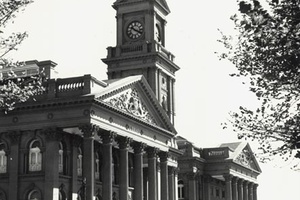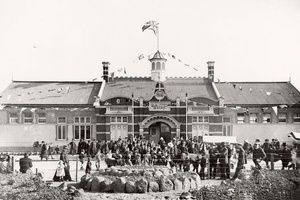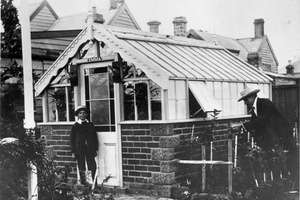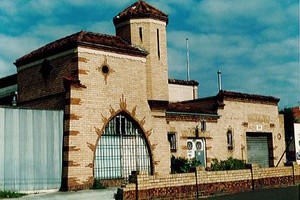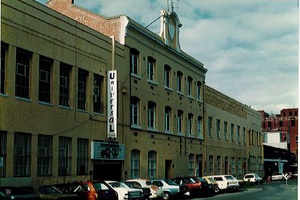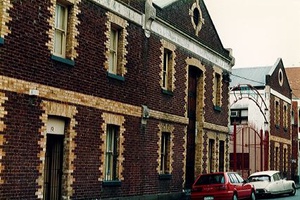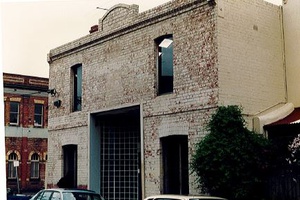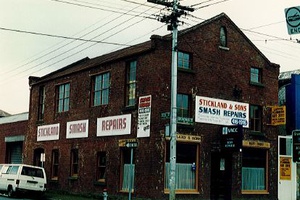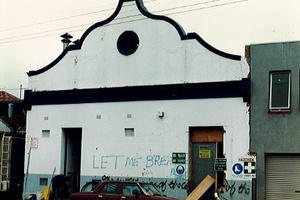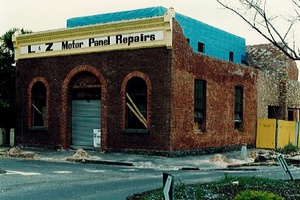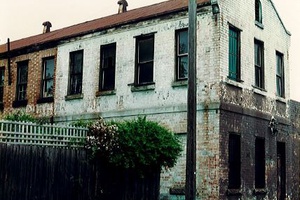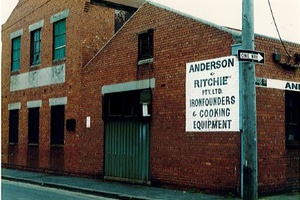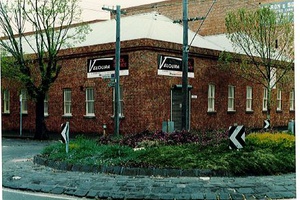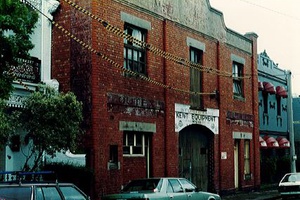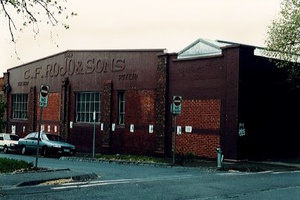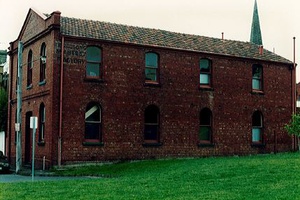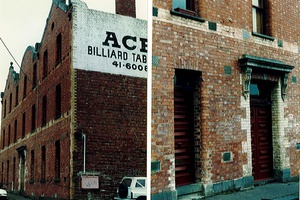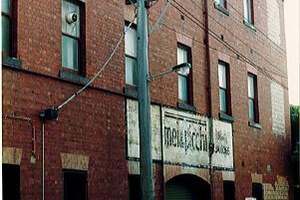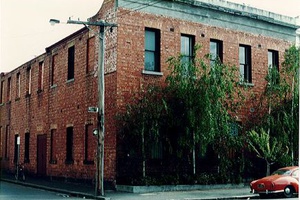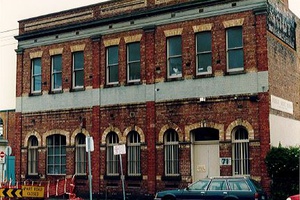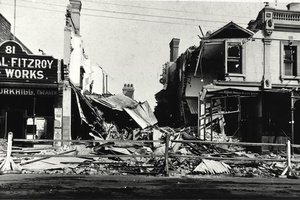This item is a part of these Themes
Demolition and Change
Jump To ThemeThere are other records in this place with a similar theme. Explore this theme by jumping to it from here. You can jump back to this piece later.
This item is a part of these Themes
Shops and Businesses
Jump To ThemeThere are other records in this place with a similar theme. Explore this theme by jumping to it from here. You can jump back to this piece later.
Other content from this author
-
Opening of the Fitzroy Municipal Baths
On the 21st October 1908 the Fitzroy Municipal Baths were opened by Councillor F.R. Chapman, Mayor. The Fitzroy Swimming Pool is located at Alexandra Parade, Fitzroy.
LinaFavrin
-
c.1890 11-13 Reid Street, North Fitzroy
In the backyard with Gilbert Goodenough standing at the door of a glasshouse. James or Theodore Goodenough stands to the right.
LinaFavrin
-
Avon Butter Factory, 218 Nicholson Street, Fitzroy
Built in 1933 for the Fitzpatrick Brothers, this building was designed to function as both a butter factory and retail dairy outlet, and operated initially under the registered name "Avon Butter Factory".
LinaFavrin
-
ACME Shirt Factory/La Mode Corset Factory, 31-39 Victoria Street
This building was was built in the late 1880s as the Acme Shirt Factory and by early 1900s it was one of the largest factories in Fitzroy housing offices, sales rooms, cloth stores, cutting & sewing departments, a steam laundry, iron & pressing rooms and stables. It was later taken over by La Mode Corsets Pty. Ltd as a corset factory until the late 1960s.
LinaFavrin
-
Harrison’s Cordial Factory & Stables, 8-12 Spring Street
Started as a small ginger beer factory on this site in 1866 by Robert Harrison, the factory expanded into one of the largest and longest surviving Fitzroy cordial factories, producing a wide range of cordials, aerated waters and mineral waters.The firm still operating as R. Harrison Pty. Ltd. well into the 1950s. The bi-chrome brick buildings on the south east corner of Spring and Argyle Streets. are perhaps the most impressive factory in Fitzroy and was classified on the Historic Buildings Register.
LinaFavrin
-
Harrison’s Cordial Factory & Stables, 8-12 Spring Street
Started as a small ginger beer factory on this site in 1866 by Robert Harrison, the factory expanded into one of the largest and longest surviving Fitzroy cordial factories, producing a wide range of cordials, aerated waters and mineral waters.The firm was still operating as R. Harrison Pty. Ltd. well into the 1950s. The bi-chrome brick buildings on the south east corner of Spring and Argyle Streets. are perhaps the most impressive factory in Fitzroy and was classified on the Historic Buildings Register.
LinaFavrin
-
Bull's Coachbuiling Works, 354 Fitzroy Street
Believed to have been built in around 1891, it was first occupied by J. Hackett, a carriage builder well-known for his "Safety cabs". By 1910, another prominent Fitzroy carriage-builder, James Bull, had taken over and remained for over 15 years. Like several other industrial sites in Fitzroy, it has a long association with the transport service industry stretching through the eras of both the horse and motor car.
LinaFavrin
-
Burston & Treleaven’s Boot Factory, 68 Leicester Street (cnr. Fitzroy St.)
This is another two-storied boot factory typical of the medium-sized boot factories that flourished in Fitzroy between 1880 and the 1930s. The building was completed in August 1902 for for G. Burston & F. Treleaven, a bootmaking firm and the company continued operating the factory until the 1930s. . In 1941, the building was listed as containing "apartments", but by 1951 it was again in use as a factory, with the Gordon Cardboard Box Co. as occupiers.
LinaFavrin
-
James Reilly’s Flourmill, 433 Brunswick Street (cnr. Cecil St.)
Built in 1869, a former flourmill, it is believed to be the oldest surviving industrial building in Fitzroy. It has the typical form of a 19th century flourmill, with two main floors for the machinery and an upper loft for grain storage. Originally there were two small cottages at the rear of the mill built for mill workers.James Reilly, an experienced milling engineer from Cork, is thought to have been the first operator of this mill but later Robert Swan took over the Brunswick St. mill in 1875-6 and operated it under the name "Fitzroy Flour Mills”. The sign "Est 1857" above the door, refers to the firm Strickland & Sons, a coach builder who bought the building in in the early 1920s.
LinaFavrin
-
Fitzroy Ice Works, 95-101 Westgarth Street
Dated as early as 1888, the "Dutch gabled" facade is what's left of the original building first occupied by the Produce & Refrigerating Co. It was at about this time that refrigeration technology was first being widely introduced in Victoria for ice-making and the cold storage of dairy products, meat and beer. The site continued to be occupied by various companies associated with the refrigerated food and ice industry for over a hundred years.
LinaFavrin
-
John Lancaster's Shoeing Forge, 423 Napier Street (cnr. Westgarth St.)
The building was built in about 1888 for a leading Fitzroy farrier, John Lancaster, as a branch works to compliment his main forge in Gertrude Street, Fitzroy.It is believed to have been the oldest surviving blacksmiths shop in Fitzroy.The building was then taken over by Lightning Panels in the 1950s and used as a panel beaters’ workshop.
LinaFavrin
-
Wynn's Boot Factory, 132-4 Leicester Street
The building was occupied by a succession of footwear manufacturers from when it was built in about 1880. The earliest Proprietor was J.H. Wynn and finally H.C. Gordon Pty. Ltd by 1920 when it was taken over by Anderson & Ritchie’s foundry.
LinaFavrin
-
Anderson & Ritchie’s Iron Foundry, 143 Rose Street (cnr. Young St.)
Originally begun near the corner of Young & Rose Streets, the site was used by Randall, Thomas & Co manufacturing churns, hat rakes and trucks during the 1880s. It was later taken over by Johnston & Beighton, malleable iron founders producing components for agricultural implement makers throughout Australia.By 1910, Anderson & Ritchie had taken over Beighton’s foundry and were using it to manufacture stoves and kitchen ranges. Anderson & Ritchie continue in business as one of the last traditional iron foundries in inner Melbourne. They now produce ornamental iron lacework and columns and a wide range of other products in addition to stoves.
LinaFavrin
-
The American Candy Co., 157 Kerr Street (cnr. Napier St.)
The single storey brick building was built in about 1890 for the proprietor of the American Candy Co., MacPherson Robertson. It was later occupied by Walter H. Hooper, as a paper box factory in 1900. Subsequently it was taken over by the Fitzroy Box Factory by 1920 which is believed to have been a subsidiary of MacRobertsons producing fancy cardboard packages for the confectionery works
LinaFavrin
-
MacRobertson’s Confectionery Works, Argyle, Gore, Smith, Rose & Kerr Streets.
Started at the back of his mother’s small cottage in Argyle Street, MacPherson Robertson confectionery empire was well established in a single-storied timber factory at 145-9 Argyle Street by 1885. MacRobertson was one of the first manufacturers in Fitzroy to use electricity to drive all his machinery. By 1923, MacRobertson was making 700 different types of confectionery and by 1930, his Fitzroy works sprawled over 30 acres with 19 different buildings in which a total of 2,600 were employed.
LinaFavrin
-
Fitzroy Ironworks, 129-131 Greeves Street
This building was erected in 1890 for the firm A. Horne & Son as Fitzroy Ironworks. Alexander Horne, the founder, established his blacksmith shop in Smith St. in 1858, and subsequently the firm operated at 302 Gore St. (just north of Greeves St.), before moving around the corner to this building. Their main products were domestic and builders’ ironwork.In 1924, this building was taken over by the company Crankless Engines (Aust.) Ltd. and was used as a workshop and design office for developing and testing prototypes of a novel engine, a crankless engine , invented by the well- known Melbourne consulting engineer A.G.M. Mitchell. By the late 1930s this building had been taken over by the Kent Equipment Manufacturing Co., who produced office stationery and furnishings.
LinaFavrin
-
C.J. Rojo & Sons, 237-253 Napier Street (cnr. St. David St.)
This building was built in 1929 for C.J. Rojo & Sons, who operated as furniture manufacturers and wood turners. This firm was originally established in Fitzroy in 1877, by Cristobal Francis Rojo, and moved to Melbourne in 1883, returning to Fitzroy in 1929 and were still operating at this site in the early 1980s.
LinaFavrin
-
Ferguson’s Mantle Factory, Wood Street
Built shortly after 1900, it was first occupied by Mr W. Ferguson as a clothing factory in 1905. By 1930, the building was occupied by Mr R. Aitken Pryor, a formerly manager of the Acme Shirt Factory, who was apparently also using it as a clothing factory. In later years the building was occupied by a variety of different manufacturers who produced an odd collection of goods including chemicals, boots, confectionery and fishing rods
LinaFavrin
-
Lewis & Whitty’s Blacking Factory, 52-54 Charles Street
This building was built for the firm of Lewis & Whitty in about 1880. Lewis & Whitty were prominent boot blacking manufacturers as well as a number of other chemical products such as “Odourbane" disinfectant. They later had another factory in Alexandra Parade, Clifton Hill. By 1910, a wire mattress manufacturer, Edward H. Luxford was occupying the building, and by 1920 he was sharing it with Parsons & Lewis, hair dealers. By 1941, Nicholas & Mayne, furniture manufacturers, were occupying the site and they remained there until at least the early 1960s.
LinaFavrin
-
Guest’s Boot Factory, 9 John Street
Originally built as a boot factory in 1888, John Guest had the factory for less than 10 years before it was taken over by the Atlas Boot Manufacturing Co., with John Peddie as the manager. In April 1902, the factory was taken over by E. Jewell after two different occupiers. Mr. Jewell was a manufacturer of men’s & women’s lace shoes, carpet and leather slipper. His manufacturing plant was driven by a Melbourne-built "Victory" gas engine. Mr Jewell remained at the site until about 1941, when it was taken over by the current occupiers, mannequin model makers, Mei & Picchi.
LinaFavrin
-
Guest’s Boot Factory chimney, Cremorne Street
The brick chimney was originally connected to a boilerhouse at the back of Guest's boot factory
LinaFavrin
-
Spicer Bros. Boot Factory, 62 Bell Street
The brick building was built in about 1886 for boot manufacturers, Samuel Lang & Co. Mr Lang was the manager of the well-known "Ezywalkin Boot Factory” where he later sold his shoes through their 34 retail outlets in Melbourne and regional Victorian towns. By 1900, the building had been taken over by T. Davis, another boot manufacturer, followed by Howgate & Hellings, who had previously operated the "Phoenix Boot Factory” in Dorset St., Collingwood. During the 1920s and 30s, the building was used by Spicer Shoe Co. Pty. Ltd., a well known Collingwood shoe manufacturers. The site was later occupied by D. Ellerton, a slipper manufacturer, until the early 1970s
LinaFavrin
-
Iron & Piper’s Boot Factory, 71 Argyle Street (cnr. Fitzroy Street)
The two-storeyed poly-chrome brick building on the north-east corner of Fitzroy and Argyle Streets was built-during the late 1880s and spent much of its early years as a boot factory , being occupied first by Richard Norgrove and L.F. Colbath in the 1890s. It was later occupied by Iron & Piper, from about 1900, followed by Iron & Co. from around 1910 and later occupied again as a boot factory by Thomas Layton in 1920s. By 1941, the Transformers Manufacturing Co. Pty. Ltd. had taken over the site and they continued to use it as a factory until the early 1970s.
LinaFavrin
-
Two women, rear of house, Fitzroy.
Old women and young girl at rear unknown property in Fitzroy
LinaFavrin
